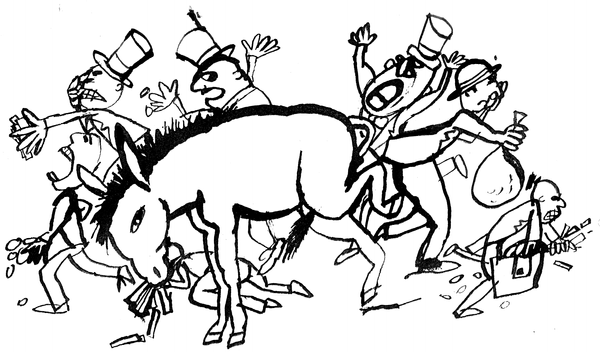In the United States there exists today, and has existed since at least the 1950s, a dominant political narrative according to which most Americans, across the history of the country, exemplify a kind of ideological “moderateness.” Democratic Party operatives and sympathizers constantly preach the virtues of occupying the political “center,” where most of the population supposedly resides. If the party caves in to its “extremist” left wing, it faces electoral annihilation. This narrative echoes, in a vulgar and opportunistic way, the postwar “liberal consensus” school of thought among social scientists and more generally the political culture, that the US has historically been an exceptional country in its relatively middle-class and Lockean-liberal character, its individualism, its relative absence of dramatic ideological clashes, of class conflict and class consciousness. Louis Hartz’s The Liberal Tradition in America, for example, published in 1955, was a classic expression of this “centrist” interpretation of American history, an interpretation that tended to explain away and criticize what dissent there was—on the left and the right—as consisting of fringe movements based on “status” anxieties, maladjusted psychologies, anti-intellectual impulses, hysterical moralism, and the like.
For the centrist establishment, then, left-wing and right-wing dissidence is simultaneously pathological and, in the broad sweep of American history, aberrational. The US is essentially a middle-of-the-road, bourgeois country, which is why radical movements have usually failed and are doomed to failure in the present and future.
Since the 1960s, scholars have subjected this creed to devastating criticism, but it continues to hold sway, in some form, even over sophisticated academics who ought to know better. An early critique was given by Michael Paul Rogin in his brilliant The Intellectuals and McCarthy: The Radical Specter (1967), which systematically exposed the flaws in liberal analyses of “protest politics” (notably the assimilation of McCarthyism to an earlier tradition of agrarian radicalism, as if “irrational” left populism was to blame for McCarthy). Later scholars have shown that US history contains just as much class conflict and class consciousness as the history of Western Europe; Sean Wilentz’s 1984 article “Against Exceptionalism: Class Consciousness and the American Labor Movement, 1790–1920” is a compelling statement of this point of view.
Recently, my own book Popular Radicalism and the Unemployed in Chicago during the Great Depression (2022) has criticized liberal interpretations of the 1930s, which tend to dismiss the idea that there was much radical potential in popular collective action of the time. Supposedly even in the 1930s, the quintessential “collectivist” decade, the American masses remained broadly subject to the hegemony of bourgeois culture, loyal to the distinctive US political economy, and uninterested in radical social change. After all, they adored Franklin Roosevelt and rushed into the open arms of the Democratic Party in 1936. Anti-radicalism thus “runs in the very DNA of this country” (to quote Nikole Hannah-Jones from a different context), time after time frustrating the hopes of socialists, and it is futile for activists to fight against these dominant anti-radical currents.
